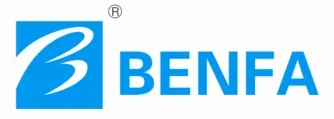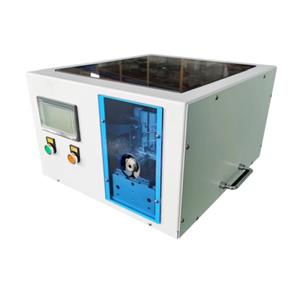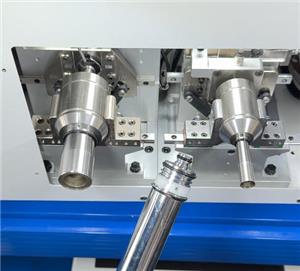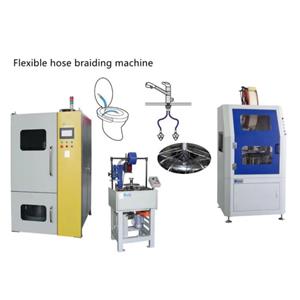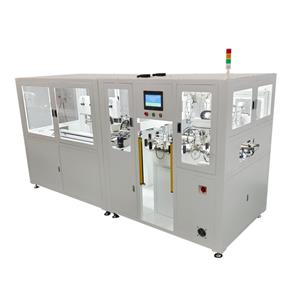Precision and Intelligence — The Advanced Electrical Control System Behind Modern Hose Manufacturing
Introduction
In the age of intelligent manufacturing, the success of any production line depends not only on mechanical strength but also on the precision, stability, and intelligence of its electrical control system. In hose production — particularly in braiding and spiral reinforcement processes — every millimeter of wire placement, every rotation speed, and every layer synchronization must be precisely managed. The new Electrical Control System for hose braiding and spiral machines represents a major technological step forward in ensuring that precision, efficiency, and safety coexist in industrial operations.
This control system integrates automation, digital monitoring, and intelligent fault detection to optimize the performance of machines used for producing high-pressure hoses. It ensures that each hose produced meets strict quality standards, while minimizing downtime and energy waste.
The Heart of Intelligent Manufacturing
In traditional manufacturing, operators had to rely on manual calibration and experience to maintain production stability. However, as demand for high-performance industrial hoses has increased, manual systems are no longer capable of maintaining consistent accuracy under complex conditions.
The new intelligent control cabinet is the “brain” of modern hose braiding and spiral machines. It manages every mechanical and electrical movement with real-time precision. By integrating programmable logic controllers (PLC), servo drives, frequency converters, and digital sensors, it transforms ordinary equipment into a smart, self-regulating production system.
System Overview
The control cabinet is designed with both functionality and safety in mind. The structure is modular, clean, and easy to maintain, while the layout of components is optimized for heat dissipation and accessibility.
Main Components
Programmable Logic Controller (PLC):
The central processing unit that executes all control commands. It receives data from sensors, interprets operator input, and coordinates machine actions.Servo Drive and Motor System:
Provides precise motion control for the braiding or spiral process. The servo system ensures accurate synchronization between rotation and wire feeding speed, which directly affects hose quality.Frequency Converters (Inverters):
Adjust motor speeds smoothly to maintain optimal performance during acceleration, deceleration, and continuous operation.Circuit Breakers and Power Modules:
Ensure stable power supply and protection against voltage fluctuations, overloads, or short circuits.Signal Relays and Communication Boards:
Facilitate real-time communication between the control system and peripheral devices, such as wire feeders, sensors, and touch-screen panels.Touchscreen Human-Machine Interface (HMI):
The HMI allows operators to monitor system status, set production parameters, and view operational data intuitively.Emergency Safety Systems:
Include physical switches, overload protection, and fault alarms designed to ensure operator safety and prevent damage to the machine.
Intelligent Control Logic
At the core of the system lies its intelligent control logic. The PLC continuously collects data from multiple sensors — including wire tension sensors, rotational encoders, and speed detectors — and uses it to regulate machine motion with microsecond accuracy.
1. Real-Time Synchronization
During hose braiding or spiraling, the relationship between mandrel rotation, wire feeding, and carrier speed must remain perfectly synchronized. The system’s real-time feedback loop ensures all motions remain coordinated even under changing production speeds.
2. Adaptive Tension Control
Tension consistency is critical for hose uniformity. The intelligent system automatically adjusts wire feeding torque to maintain ideal tension, compensating for wire thickness variations and machine wear.
3. Predictive Maintenance
Sensors continuously monitor temperature, vibration, and current levels within the system. When abnormal readings appear, the PLC generates early warnings, allowing operators to perform maintenance before failures occur — significantly reducing downtime.
4. Data Recording and Analysis
Every production run is recorded and stored digitally. Parameters such as rotation speed, wire pitch, and layer count can be reviewed later for traceability and process optimization. This is especially valuable for manufacturers seeking ISO or CE certification.
5. Error Detection and Safety Response
The system’s automatic error diagnosis identifies issues like motor overloads, encoder faults, or wire breaks. When detected, it immediately stops the affected section and displays the fault type and location on the HMI, helping operators resolve issues quickly.
Design and Engineering Highlights
1. Modular and Compact Structure
The control cabinet features a three-zone modular layout:
Power input and distribution section
Control logic and relay section
Communication and output control section
This design improves accessibility, simplifies wiring, and minimizes electromagnetic interference.
2. Efficient Heat Management
Industrial production generates heat, especially when multiple servo drives are running simultaneously. The system includes ventilated heat channels, industrial fans, and intelligent temperature sensors to maintain a stable operating environment.
3. Safe and Durable Wiring
All wiring uses flame-retardant, industrial-grade cables with labeled terminations for easy identification. Connections are reinforced with vibration-resistant terminals to prevent loosening during continuous machine operation.
4. Plug-and-Play Maintenance
Components like relays, drives, and circuit breakers are mounted using modular rails, allowing quick replacement without extensive rewiring. This makes maintenance faster and safer.
Integration with Hose Braiding and Spiral Machines
This electrical system is compatible with various hose production machines, including:
Hose Braiding Machines: Used for producing stainless steel or polyester-braided flexible hoses for plumbing and industrial use.
Rubber Hose Spiral Machines: Designed for high-pressure rubber hoses used in hydraulic systems.
Wire Winding Machines: Applied for precision control in cable reinforcement or composite tubing.
The intelligent control system automatically synchronizes all motion axes — such as spindle rotation, wire carriers, and feeding units — ensuring uniform wire angles and balanced reinforcement in every hose.
Operational Advantages
1. Stability and Consistency
The control system eliminates fluctuations during high-speed operation, maintaining steady output quality even during long production runs.
2. Energy Efficiency
Smart frequency control adjusts motor speed based on real-time load, reducing energy consumption by up to 20%.
3. Enhanced Safety
Built-in emergency stop systems and automatic shutdown under fault conditions protect both operators and machinery.
4. User-Friendly Interface
Operators can manage production through the intuitive touchscreen interface — setting hose size, wire count, and rotation speed with just a few taps.
5. Production Flexibility
Multiple recipe storage allows users to quickly switch between product specifications without reprogramming the machine.
Quality Assurance and Reliability
Each control system undergoes rigorous testing before installation, including:
High-voltage insulation test
Function simulation test
Thermal stability assessment
Signal transmission accuracy verification
Only after passing all tests is the system installed on hose production lines. This strict quality control guarantees reliability under continuous operation.
Contribution to Industry 4.0
The rise of Industry 4.0 has redefined manufacturing through digitalization, connectivity, and automation. The new control system aligns perfectly with these trends.
1. Remote Monitoring and Cloud Integration
With optional IoT modules, the system can transmit performance data to cloud platforms. Engineers can monitor real-time production from remote devices, analyze efficiency, and predict potential issues.
2. Smart Data Analytics
Historical data collected by the control system can be analyzed using AI algorithms to optimize wire tension settings, predict tool wear, and improve production planning.
3. Digital Twin Technology
The system can be integrated into digital twin environments — virtual models of the production line that simulate operations for testing and optimization without interrupting real production.
Environmental and Safety Standards
Compliance with global safety and environmental standards is built into the system design:
CE Certification for electrical safety
ISO 9001 Quality Management compatibility
RoHS Compliance to limit hazardous substances
Low-Noise and Energy-Efficient Operation
By meeting these standards, the system ensures both workplace safety and environmental responsibility.
Maintenance and Lifecycle Management
Regular maintenance is simplified by built-in diagnostic features. The HMI displays maintenance reminders and service logs, guiding technicians step-by-step.
Key maintenance features include:
Real-time component status overview
Auto-generated maintenance schedules
Alarm history with error codes
Predictive replacement recommendations
With proper maintenance, the system’s operational lifespan exceeds 10 years, making it a long-term investment for industrial manufacturers.
Impact on Production Efficiency
Integrating this control system can improve overall production efficiency by 15–30% depending on operational scale. Benefits include:
Reduced downtime from predictive maintenance
Shorter setup times between product runs
Lower material waste from consistent wire control
Increased throughput due to stable operation
Such gains contribute directly to higher profitability and competitiveness in the global hose manufacturing market.
Future Developments
The evolution of control technology continues, and future upgrades may include:
AI-driven adaptive control algorithms for self-optimization
Wireless communication modules for remote diagnostics
Energy recovery systems that reuse braking energy from motors
Augmented reality interfaces for operator training and troubleshooting
These innovations will continue to expand the capabilities of hose manufacturing systems, setting new standards for precision and performance.
Conclusion
The Electrical Control System is more than a power cabinet — it is the central intelligence that drives the performance, reliability, and efficiency of modern hose manufacturing machines. With its blend of automation, real-time monitoring, and safety assurance, it provides the foundation for achieving consistent, high-quality hose production at industrial scale.
By combining advanced PLC logic, servo precision, and digital feedback control, this system empowers manufacturers to meet growing market demands for high-pressure, high-accuracy hoses while reducing operational costs and energy consumption.
As global industries continue to embrace automation and sustainability, such intelligent systems will remain at the forefront of innovation — ensuring that every product leaving the production line reflects precision, reliability, and technological excellence.
